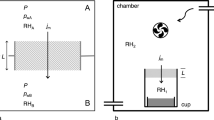Abstract
A specially constructed stress cell, permitting variation of degree of restraint, was used to measure the hygral stress produced in thin-walled hardened cement paste cylinders due to water absorption. The effects of porosity, relaxation and relative humidity on the hygral stress were investigated using a Portland and a Portland composite cement. It was found that capillary suction transports water to the gel pores causing an initial rapid stress development. This is followed by a gradual increase over ca. 3 days governed by the redistribution kinetics of water molecules in the cement gel. The hygral stress developed is proportional to the volume fraction of cement gel. The cement gel itself produces a uniaxial stress of ca. 8 MPa for degrees of restraint above ca. 80%. About 70% of the stress is caused by changes in surface energy at the gel particle/pore water interface; the remainder is due to the disjoining pressure. A change in surface energy of 0.17 J/m2 was estimated based on measurements of specific surface and porosity. The development of hygral stress is also controlled by stress relaxation. This appears to be enhanced by the effect of the disjoining pressure which weakens bonds between gel particles to create a more mobile structure under stress.
Résumé
Les contraintes hydriques causées par absorption d'eau dans des cylindres creux de pâte de ciment durcie à paroi mince ont été mesurées au moyen d'une cellule de contrainte spécialement conçue à cet effet et permettant de varier le taux d'empêchement des déformations. Les effets de la porosité, de la relaxation et de l'humidité relative sur les contraintes hydriques ont été étudiées en utilisant des CPA et CPJ. Il a été mis en évidence que la succion capillaire transporte l'eau vers les nanopores, provoquant ainsi une croissance rapide des contraintes au départ. Il s'ensuit un accroissement progressif sur environ 3 jours régi par la cinétique de répartition des molécules d'eau dans le gel de ciment. Les contraintes hydriques mises en oeuvre sont proportionnelles à la fraction volumique du gel C-S-H. Le gel
C-S-H provoque une contrainte uniaxiale de l'ordre de 8 MPa pour des taux d'empêchement des déformations supérieurs à 80%. Environ 70% de la contrainte est due à des changements de l'énergie de surface à l'interface particule de gel et de l'eau contenue dans le pore; le reste est dû à la pression de disjonction. Une variation de l'énergie de surface de 0,17 J/m2 a été évaluée sur la base de mesures de la surface spécifique et de la porosité. Le développement des contraintes hydriques est également gouverné par la relaxation des contraintes. Ceci est renforcé par l'effet de la pression de disjonction, qui affaiblit les liaisons entre les particules de gel et produit une structure plus mobile sous l'effet de contraintes.
Similar content being viewed by others
References
Fleischer, W and Springenschmid, R., ‘Investigation of the causes of surface cracks (network cracks) in concrete pavements’,Forschung, Straßenbau und Straßenverkehrstechnik 651 (1993).
Wittmann, F. H., Fundamental principles of a model describing the characteristic properties of concrete’,Schriftenreihe Deutscher Ausschuß für Stahlbeton 290 (1977), only available in German.
Setzer, M. J., ‘Effect of water on the properties of concrete’,Schriftenreihe Deutscher Ausschuß für Stahlbeton 280 (1977), only available in German.
Winslow, D. N. and Diamond, S., ‘Specific surface of hardened portland cement paste as determined by small-angle X-ray scattering’,J. Amer. Ceramic Soc. 57 (1974) 193–197.
Völkl, J. J., Beddoe, R. E. and Setzer, M. J., ‘The specific surface of hardened cement paste by small-angle X-ray scattering. Effect of moisture content and chlorides’,Cem. Concr. Res. 17 (1987) 81–88.
Porod, G., ‘Small-angle X-ray scattering from densely packed colloidal systems’, Part I.Kolloid-Z 124 (1951) 83–114, Part II.Ibid. Kolloid-Z,125 (1952) 51–57, 108–122, only available in German.
Powers, T. C. and Brownyard, T. L., ‘Studies of the physical properties of hardened portland cement paste’,Portland Cement Assoc. Bulletin 22, Chicago 1948.
Winter, K., Krus, M. and Künzel, H. M., ‘Moisture transport in fine porous materials’,Internat. Zeitschrift für Bauinstandsetzen 3 (1997) 15–28, only available in German.
Bangham, D. H. and Fakhoury, N., ‘The swelling of charcoal’,Proc. Roy. Soc. (London) A 130 (1931) 81–89.
Hiller, K. H., ‘Strength reduction and length changes in porous glass caused by water vapor adsorption’,J. Appl. Phys 35 (1964) 1622–1628.
Badmann, R., Stockhausen, N. and Setzer, M. J., ‘The statistical thickness and the chemical potential of adsorbed water films’,J. Colloid Interface Sci. 82 (1981) 534–542.
Author information
Authors and Affiliations
Rights and permissions
About this article
Cite this article
Beddoe, R.E., Lippok, R. Hygral stress in hardened cement paste. Mat. Struct. 32, 627–634 (1999). https://doi.org/10.1007/BF02481700
Received:
Accepted:
Published:
Issue Date:
DOI: https://doi.org/10.1007/BF02481700




